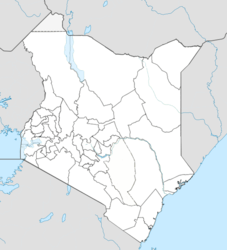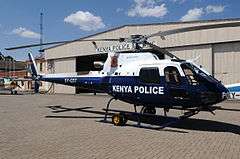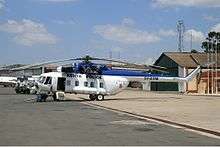Kenya Police
The Kenya Police Service is a national body in charge of law enforcement in Kenya. It is subordinate to National Police Service which is headed by Inspector General of Police who exercises independent command over the Service. Kenya Police is headed by Deputy Inspector General. Kenya Police is divided into Service Headquarters, Formations, General Duty Commands and Training Institutions. General Duty commands are further divided into Regional, County, Sub-County Commands, Police stations and Police Posts in that hierarchy. Ultimately all these elements report to, and are accountable to Deputy Inspector General based at Kenya Police Headquarters in Nairobi.
| Kenya Police Service [1] Polisi wa Kenya | |
|---|---|
The Kenya Police patch. | |
 Flag of the Kenya Police | |
| Common name | Kenya Police Karau/Polisi |
| Motto | Utumishi kwa Wote (English: "Service to All") |
| Agency overview | |
| Formed | 1906 [2] |
| Employees | approx. 101,000=[3][4][5] |
| Jurisdictional structure | |
| Operations jurisdiction | KEN |
 | |
| Map of Kenya Police Service [6]'s jurisdiction. | |
| Size | 581,309 square kilometres (224,445 sq mi) |
| Population | 47,564,000 Kenya |
| Governing body | Kenya |
| General nature | |
| Headquarters | Vigilance House, Harambee Ave, Nairobi |
| Police Officers | 80,000=(approx)[3][4] |
| Agency executive |
|
| Parent agency | National Police Service |
| Units | List
|
| Counties | Counties of Kenya |
| Facilities | |
| Airbases | Wilson Airport |
| Mil Mi-17, MBB Bo 105 Cessnas | 15 |
| Website | |
| kenyapolice.go.ke | |

Administration Police Service is commanded through a hierarchy separate from that of the Kenya Police.[8] For other state security bodies see Law enforcement in Kenya.
History
The Kenya police force was established as a British colonial police force in 1907. From the 1887 to 1902 policing was provided by the East Africa Trading Company. After 1902 the Kenya-Uganda Railway introduced their own police units.[9]
In 1906 the Police Ordinance was established to create a new force in 1907, the Nairobi Mounted Police within the jurisdiction of the East Africa Protectorate. The current force's name came into effect in 1920 with the newly created British Kenya Colony.
The colonial force was made up mainly of British and Indian recruits as senior officers and Africans amongst lower ranks.[9]
Following Kenya's independence, the British officers were replaced with local Kenyan members.
The Current Structure
Regional Police Commander in charge of a region (Formerly provinces). County Police Commander in charge of County Formations. Sub-County Police Commander in charge of Sub-Counties (Previously called District). Officer Commanding Station (Ward Commander and or in charge of Police Posts and/or Patrol Bases).
Current Formations
The current Inspector General is Hillary Mutyambai following the introduction of the position to replace the police commissioner. He is the third holder of the position after Joseph Boinnet. The Kenya Police is divided into the following formations;[10] the unit commandants/directors generally hold the rank of Assistant Inspector General of Police (AIG), or Commissioner of Police (CP):
- General Service Unit (GSU): both headquarters and training school are in Nairobi; the Commandant is Douglas Kanja
- Diplomatic Police Unit: Patrick Tito leads the unit from the Nairobi offices.
- Directorate of Criminal Investigation: It is headquartered in Karura, Nairobi. DCI had different directors [11]. George Kinoti took leadership in January 2018.
- Traffic Police Department: headed by Samwel Kimaru, with main offices in Nairobi
- Kenya Police College: located in Kiganjo; commanding officer is [Kingori Mwangi]]
- Kenya Police Air Wing: has its offices in Nairobi, led by Colonel Rodgers Mbithi
- Kenya Railways Police: commanded in Nairobi by David Bunei
- Kenya Police Dog Unit: unit chief is John Mwinzi is located in Nairobi.
- Tourist Police Unit: led by Jostine Barmao with offices in Old Nairobi Area Provincial Police Hqrs.
- Kenya Airports Police Unit: headed by with offices in Nairobi and three divisions (Nairobi, Eldoret, Moi airports)
- Maritime Police Unit: headquartered at Kilindini Harbour in Mombasa, commanded by [Mr Ng'eno]
Societal impact
Following a history of human rights abuses by the Kenya Police, efforts are being made to reform the force.[12] Kenyan policemen are poorly paid and have to make use with archaic housing that has not been expanded or renovated since the 1970s. This has made them very susceptible to corruption and crime. Extortion and bribery are not unknown practices and the Kenyan people rank the police among the most corrupt bodies in the country.[13][14] In July 2010 the Minister, Prof. George Saitoti, announced a 28% pay increase for junior officers and a 25% pay increase for senior officers. This reform means that the most junior officer, a Police Constable, shall receive Ksh 21,000/month including allowances.[15][16]
Police ranks


The Kenya Police wear badges of rank on the shoulders (Inspector-General – Inspector) and sleeve (Senior Sergeant – Constable) of their uniform to denote their rank. In line with the ongoing reforms, the uniforms committee is also working on new insignia for the revised rank structure, which will have to be approved by the National Police Service Commission.[17] The order of Kenya Police ranks is as follows:[18]
- Inspector-General (formerly Commissioner of Police) - equivalent to the 2-star General in the Kenya Defence Forces (KDF)
- Deputy Inspector-General - equivalent to the one-star rank -Brigadier General in the KDF
- Senior Assistant Inspector-General - (equivalent to Colonel]] in the KDF
- Assistant Inspector-General - equivalent to the Lieutenant Colonel] in the KDF
- Commissioner of Police
- Senior Superintendent - equivalent to Major in the KDF
- Superintendent - equivalent to Captain in the KDF
- Assistant Superintendent - equivalent to Lieutenant in the KDF
- Chief Inspector - equivalent to [[Warrant Officer 1) in the KDF
- Inspector - equivalent to Warrant Officer 2 or Sergeant Major in the KDF
- Senior Sergeant - equivalent to Senior Sergeant in the KDF
- Sergeant - equivalent to Sergeant in the KDF
- Corporal
- Constable - equivalent to Private in the KDF
Former Kenya Police ranks and insignia can be found at this reference.[19]
Commissioners of Police & Inspectors-General
From 1906 to 1964 the force was headed by British officers.
The following officers have to date served in the capacity of Commissioner of Police:[20]
- Bernard Hinga 1964–1978
- Ben Gethi 1978–1982
- Bernard Njinu 1982–1988
- Phillip Kilonzo 1988–1993
- Shedrack Kiruki 1993–1996
- Duncan Wachira 1996–1998
- Philemon Abong’o 1998–2002[21]
- Edwin Nyaseda 2002–2003[21]
- Major General Mohammed Hussein Ali 2004–2009[22]
- Mathew Kirai Iteere 2009–2012
The following officers have served as Inspector-General:
- David Mwole Kimaiyo 2012–2014[23][24]
- Acting Inspector-General Samuel Arachi Deputy Inpsector General-Administration Police Service 31 December 2014 - March 11, 2015
- Joseph Kipchirchir Boinett March 11, 2015 - March 2019 [25]
- Hillary Nzioki Mutyambai April 8, 2019[26]
Ongoing changes
Following the promulgation of the new Constitution of Kenya on 27 August 2010, as laid down in Chapter 17 Part 4, the Kenyan police forces is undergoing a series of reforms. Hence called The Kenya Police Service, it is now headed by a Deputy Inspector-General and the division of its functions are organised to take into account the devolved structure of government in Kenya.
Equipment
The equipment of the Kenya Police and General Service Unit (GSU), a paramilitary wing of the Kenyan Police, comprises:
- 1 AS350 B3e Ecureuil helicopter (January 2012) (France), June 2012, crashed, total loss, with 6 fatalities.[27]
- 7 Cessna aircraft, the latest (2011) being a Cessna 208 Caravan light aircraft (United States)
- 4 Mil Mi-17 helicopters (Russia)
- 3 Bell 206 (United States)
- 3 AW139 One crashed without fatalities resulting in write off. (Italy)
- 1 AW119 Koala (Italy)
- Glock Pistol
- CZ 75
- G 3
- Browning Hi-Power
- H&K MP5
- AK-47
- 30 VN-4 (GSU)[28]
See also
- Administration Police
- Kenya Defence Forces
- Kenya Coast Guard Service
- Corruption in Kenya
- Elizabeth Nyaruai
- For other state security bodies see Law enforcement in Kenya
References
- "National Police Service". www.nationalpolice.go.ke.
- "Strategic Plan" (PDF). www.humanrightsinitiative.org.
- Interpol Kenya. "FAQ". Interpol.
- "Record number of Kenya police graduates in April". Aa.com.tr. 24 April 2014. Retrieved 20 June 2018.
- "Govt Finishes Police Digital registration". nation.co.ke. 19 March 2019. Retrieved 14 December 2019.
- "National Police Service". www.nationalpolice.go.ke.
- http://www.nationalpolice.go.ke/
- "(2010) Crime and Development in Kenya".
- Sommer, Hans-Martin. "History of the Police in Kenya 1885-1960". Cite journal requires
|journal=(help) - "Kenya Police Formation". Kenya Police. Archived from the original on 27 July 2010.
- "Kibaki names new CID boss". Daily Nation.
- "kenyapolice.go.ke". Archived from the original on 11 July 2006. Retrieved 18 June 2006.
- Survey: Police are most corrupt in Kenya. United Press International. 18 July 2008
- Kenya police still most corrupt. BBC News. 21 August 2007.
- "Kenya police get pay raise". Daily Nation.
- "Crime and Development in Kenya".
- "Number of senior police ranks reduced to boost service". Business Daily Africa. 30 January 2013. Retrieved 6 May 2014.
- Commission on the Implementation of the Constitution. "The National Police Service (Amendment) Bill, 2013". Retrieved 6 May 2014.
- Kenya Police. "Kenya Police - Insignia". Retrieved 6 May 2014.
- "Former Commissioners". Kenya Police. Archived from the original on 31 July 2010.
- Daily Nation website, 30 December 2008: Former police chief Nyaseda dies in hospital
- Daily Nation, 8 September 2009: Kibaki moves Ali, names new Kenya police boss
- -. "Kimaiyo to be sworn in Monday".CS1 maint: numeric names: authors list (link)
- Kimaiyo, David, In the Spirit of Service, Nairobi: Kipchumba Foundation, 2017.
- Nguru, Steve. "Structure and Composition - Page 3". ustawi.info.ke.
- http://www.nationalpolice.go.ke/
- Kenya Police Air Wing-becomes-first-African-customer-to-operate-Eurocopter-s-enhanced-AS350B3e-helicopter_860.html Archived 23 January 2013 at Archive.today
- Fisher Jr, Richard D. "Kenya receives 30 Norinco VN4 armoured vehicles". Jane's Information Group. Retrieved 6 March 2016.